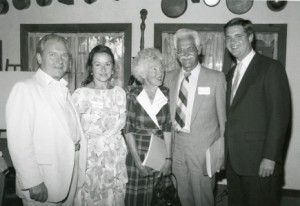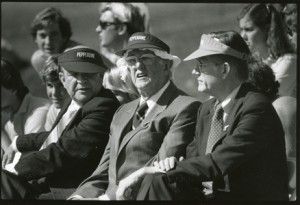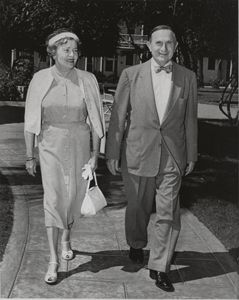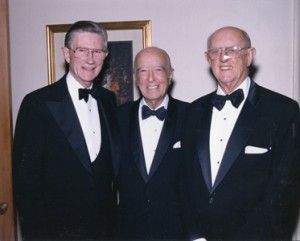The CCB, the RAC, the TAC and Towers are only a few of the names that have become ingrained in students’ vocabulary as they go about their daily routines. However, what many may not realize is that they represent the rich history of Pepperdine, as well as the ties and friendships the school has made across the years. All of the buildings named after an individual or a couple encompass a unique aspect of the story of Pepperdine. Here are some of the most common names that can be found throughout the campus and the history behind them.
1. Stotsenberg Track
It is nearly impossible to complete an undergraduate career at Pepperdine without coming across the Stotsenberg name. The track’s namesake, Dorothy Stotsenberg, established not only a special relationship with the school, but also with the city of Malibu over the years. Born in 1914, she received a bachelor’s degree in journalism from the University of Washington in Seattle before moving to Malibu with her husband Edward G. Stotsenberg in 1949. Throughout her life, Dorothy was closely involved with the arts and philanthropies, and was a regular contributor to many local publications including the Malibu Times. She also participated in marathons all over the world with her husband. This was the basis for their decision to fund the construction of the track: to provide the students and the community of Malibu with a decent place to run and train. Pepperdine has held 5K and 10K races in their name, as well as the Stotsenberg International Guitar Competition, the Stotsenberg Recital Series and a journalism scholarship. Dorothy Stotsenberg died Feb. 24, 2011 at age 97.
2. Raitt Recital Hall
The recital hall gets its name from John Raitt, a Broadway legend who donated the facility to Pepperdine. Throughout his career he starred in many musicals such as “Oklahoma!,” “Carousel” and “South Pacific.” Raitt was also cast alongside Doris Day in the film “The Pajama Game.” He was even known for frequently performing with his daughter, blues singer-songwriter Bonnie Raitt. John Raitt died on Feb. 20, 2005 at age 88.
3. Mullin Town Square
The square was named after Sharon and Terry Mullin. Sharon won her first pageant title, Miss Colorado, in 1956, as a freshman at Colorado Women’s College. Representing Colorado, she went on to win the Miss America pageant at only 18 years of age. She was also the first winner to tour Europe on an official Miss America visit. Terry Mullin was a lumber executive, owning 23 lumber building material companies in Southern California. The year ofter her Miss America tour, Sharon married Don Cherry, a singer and golfer. They had two sons but divorced in 1961 because of conflicting careers. Sharon then went on to marry Terry Mullin. In 2011, Sharon’s son was a victim of the terrorist attacks on the World Trade Center, and though they were devastating times, the couple attributes their strength and  perseverance to their faith in God. They currently split their time between Los Angeles and Honolulu.
perseverance to their faith in God. They currently split their time between Los Angeles and Honolulu.
4. Raleigh Runnels Memorial Pool
The pool was named in memory of the son of Pepperdine Chancellor Charles B. Runnels. Raleigh Neal Runnels succumbed to cancer at age 17, and through the support of Mrs. Frank Rogers Seaver and Morris B. Pendleton, the pool was dedicated on April 18, 1976. The pool hosted the 1984 Olympic Games water polo competition.
5. Seaver College
Pepperdine’s relocation to Malibu in 1972 was all thanks to the undergraduate program’s first benefactor, Blanche  Ebert Seaver, whose husband Frank Roger Seaver would become the school’s namesake. A former member of the California Naval Militia, Seaver received the highest ranking of Master Mariner, and also obtained permission to set up the Aviation Section, the second to be established in the country. Once he had left the Naval Militia, he began to work for Pan American Petroleum and Transport Company. While conducting business in Mexico, Seaver built many of the country’s first modern service stations and persuaded the national government to undertake a road-paving program. Later in life, he founded the Hydril Company, which specializes in drilling equipment and explosive arresters. It went on to become a giant in the oil industry. Frank died in 1964, and Blanche in 1994.
Ebert Seaver, whose husband Frank Roger Seaver would become the school’s namesake. A former member of the California Naval Militia, Seaver received the highest ranking of Master Mariner, and also obtained permission to set up the Aviation Section, the second to be established in the country. Once he had left the Naval Militia, he began to work for Pan American Petroleum and Transport Company. While conducting business in Mexico, Seaver built many of the country’s first modern service stations and persuaded the national government to undertake a road-paving program. Later in life, he founded the Hydril Company, which specializes in drilling equipment and explosive arresters. It went on to become a giant in the oil industry. Frank died in 1964, and Blanche in 1994.
6. George Elkins Auditorium
George William Elkins was a realty agent who helped develop Beverly Hills and Santa Monica. He is attributed with having brought big merchandising names to Wilshire Boulevard (LA Times Obituary). He founded a real estate firm in 1923 that he headed until 1989. A New Mexico native, Elkins graduated from Southwestern University in Georgetown, Texas. In 1921 Elkins got a job selling real estate in California. At that time, Beverly Hills had a population of 700. Elkins became a trustee of Pepperdine, receiving an honorary doctorate and the auditorium named after him. Elkins died in Feb. 1993 at age 93. When Elkins died, family members asked that memorial donations be made to the George W. Elkins Jr. Scholarship Foundation, named after Elkin’s first son that had preceded him in death.
7. Charles B. Thornton Administrative Center
This building that houses the Pepperdine administration was named after the deceased husband of Flora Thornton. Thornton attended Texas Tech University in the 1930s and majored in nutrition and clothing design. She moved to Washington, D.C. to try to make a musical career on Broadway. It was during her time in D.C. that she met Charles B. Thornton. They both attended Texas Tech but had not met. The two married and had two sons. Flora was a member of the Pepperdine Board of Regents as well as the academic and the building and grounds committee. President Ronald Reagan appointed her to a seven-year term to the Library of Congress Trust Fund Board. Charles B. “Tex” Thornton was a businessman who transformed Litton into a billion dollar electronics conglomerate. He was featured on the front page of Time in 1963. He died in 1981 and Flora Thornton made a multi-million dollar donation to Pepperdine in 1985. The administrative center, which cost approximately $10 million, opened in 1986.
8. George C. Page Residential Complex
Living from 1901 until 2000, George C. Page was a real estate developer and entrepreneur. Page was born in  Fremont, Neb. and was raised in a farm. He moved to California at age 16. He first worked as a busboy and a soda jerk (someone who operates a soda fountain). After raising enough capital, he founded a distribution company, Mission Pak, which shipped California fruit to customers in cold weather states. He later bought a sports car manufacturing plant, sold Mission Pak in 1946 and went into real estate development. Besides the George C. Page Residential Complex, Page has also contributed to Loyola Marymount, USC and the Children’s Hospital Los Angeles.
Fremont, Neb. and was raised in a farm. He moved to California at age 16. He first worked as a busboy and a soda jerk (someone who operates a soda fountain). After raising enough capital, he founded a distribution company, Mission Pak, which shipped California fruit to customers in cold weather states. He later bought a sports car manufacturing plant, sold Mission Pak in 1946 and went into real estate development. Besides the George C. Page Residential Complex, Page has also contributed to Loyola Marymount, USC and the Children’s Hospital Los Angeles.
9 & 10. Eddy D. Field Baseball Stadium & Helen Field Heritage Hall
Eddy D. Field was a realty agent and an investor. He attended USC and opened a Hollywood real estate and insurance business in 1927. He later added investments and development to his firm. He was a long time Pepperdine benefactor and received an honorary doctor of law degree in 1976. He served on the university’s board of directors and donated funds for the baseball stadium and the heritage hall, named after his wife. Field also served as a chairman of the Los Angeles Salvation Army advisory board.
He died on Nov. 12, 1994.
10, 11, 12, 13 &14 Leon and Margaret Rockwell Academic Center, Richard Rockwell Classroom, Richard Rockwell Towers Residence Hall, Leon Sr. Bessie M. Rockwell Dining Center, Margaret M. Rockwell Student Dining Center
As one of Pepperdine’s most generous donor couple, Margaret and Leon Rockwell have provided Pepperdine with a number of academic and residential facilities. The most recent was the Rockwell Student Dining Center in Drescher, named after Margaret Rockwell who had died in 2004. Dr. Leon Rockwell, and his son, attended the Graziadio School of Business and Management.
